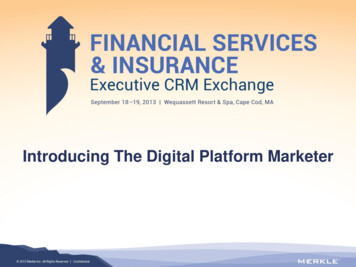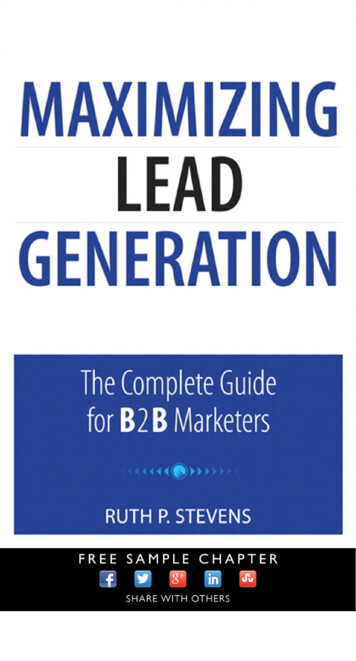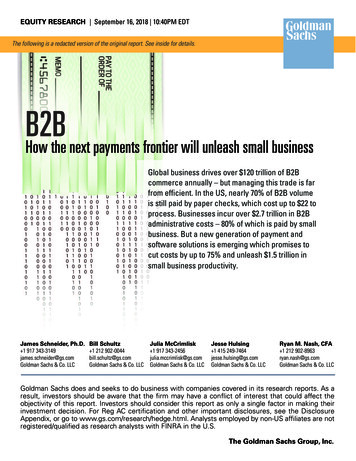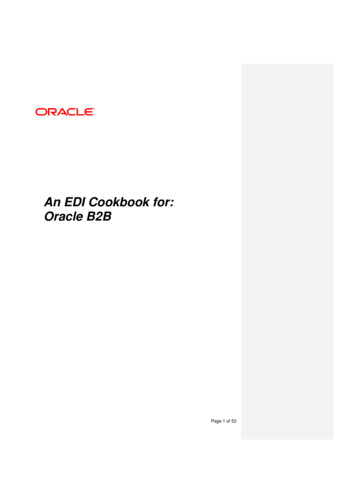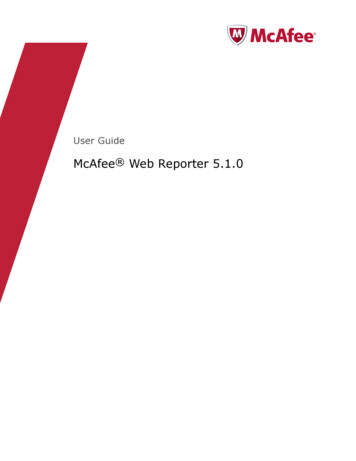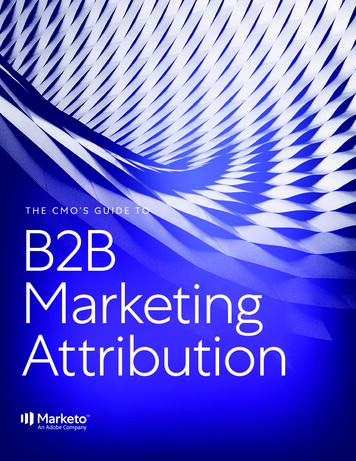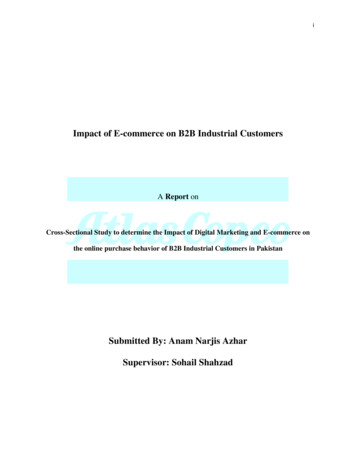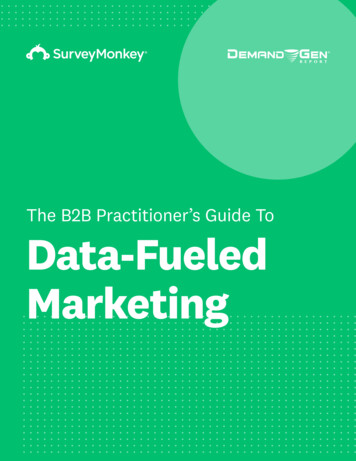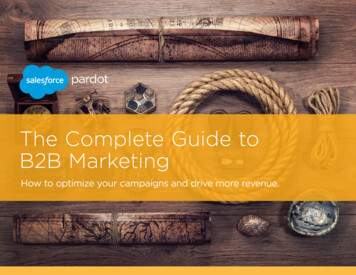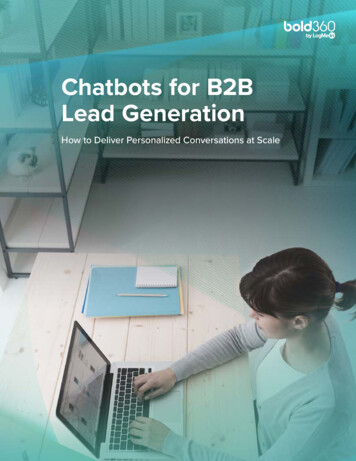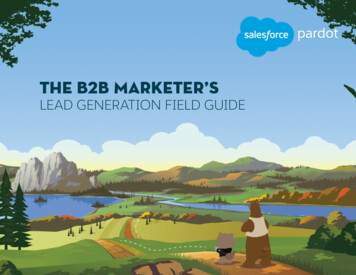
Transcription
pardotTHE B2B MARKETER’SLEAD GENERATION FIELD GUIDE
2Meet Astro and friends!They’re here to help guide you through the greatoutdoors (and this e-book) in the spirit of fun,adventure, and exploration. Why? Because that’swhat Salesforce is all about – empowering peopleto blaze their own trails and being part of somethinggreater. If you want to know more, check outTrailhead, the fun way to learn about Salesforce. Getstarted today at salesforce.com/trailhead.2 / Pardot
3IntroductionLeads can be elusive. Easily startled, and even more easilydisgruntled when disturbed by a sales call or promotional email.Rarely do you find a B2B marketer with an overabundance of leads;instead, despite the proliferation of the platforms and content thatnormally attracts them, qualified leads that can fill sales’ pipelinecan still be difficult to source.From websites, to social media, to email, and mobile apps, thereare an unlimited number of ways to communicate with clientsand prospects and share content, and most B2B marketers havea presence on some, if not all of those platforms. Having so manyways to attract buyers may seem like a good thing — especially ifyou operate on nearly all of them — but if you aren’t reaching theright audience, it’s no better than having none at all. Think of eachplatform as a kind of watering hole in the desert. Yes, some leadswill be drawn to each one, but without a discerning approach, sowill a host of other traffic, making it even harder to locate — letalone capture — the leads you need.So how do you attract the leads you need to grow your business?Two thirds of B2B marketers say content is fuel across all channels,including events, social, demand generation (Kapost), so gettingit right should be a big part of your strategy. It starts with youroffer and your message but, as with choosing the right channel,simply creating a barrage of content isn’t the answer. Your clientsand prospects are bombarded on every side by communicationsfrom dozens businesses every day. There are hundreds of emails,thousands of Facebook notifications, and a metric ton of emojis.It’s enough to send any lead scurrying back into the wilds of theworld wide web. Perhaps that’s why there’s such a strong demandfor quality, useful, immediately applicable content — and such awarm response when marketers deliver on it.Providing quality content through the right channels and platformsis important when you consider that customer experience is oneof the driving forces behind successful marketing campaigns withcustomers 5.2 times more likely to purchase from companies thatoffer a “great customer experience” (Kapost).We know that the main function of content — gated and un-gated —is to drive leads, and we know that methods like lead nurturing canincrease the quality of those leads and lead to greater conversion.So how does all this fit together? In modern marketing, yourlead generation strategy needs to be focused on providing yourprospects with a customer experience that can differentiate yourbrand, and meet their needs on any and every level.
4Gearing Up for Lead Hunting —Creating the Right Blend of Content22% of Marketers feel that content marketing is the digitalmarketing activity that will have the most commercial impact in2016 (Smart Insights), but in the customer experience-driven wildsof modern marketing, content needs to provide additional valueabove and beyond describing products and services in order to tapinto its full potential.Buyers come to you because they have a problem, a pain pointor want additional functionality for their business, and while yourproducts can offer them a solution, so can your content. Positionyour website as a resource. The content you create for it shouldbe something like another product. It should offer your buyers asolution to problems they might have, or new ways to considerproblems that their clients might have. If you aim to offer yourtarget audience something that is, will be, or should be importantto them, your content will be much more powerful in driving leads.FIELD TIP B2B MARKETER’S GUIDEWhile creating content around broad topics isn’t a badthing, the more closely applicable your themes andtakeaways are to the interests and industries of yourpreferred types of customers, the more qualified leadsyou’ll be able to generate from it.22% of Marketers feel that contentmarketing is the digital marketing activitythat will have the most commercialimpact in 2016Smart InsightsStudying a Specimen: Building a Strategy Around YourIdeal BuyerTo keep from drifting away from the profile of your ideal buyer, youshould make sure that you have your personas, mission statement,or another guiding beacon written or visually represented whereit’s easily accessible. This way when you are creating a content planor strategy for a new campaign, you’re readily able to refer to it. Italso keeps a team centered around a common goal. You shouldinvolve your sales team to ensure that your ideal buyer has allthe characteristics of their ideal lead. Together, determine wherethere is overlap between buyers who interacted with your onlinecampaigns and those that went on to close a deal with your salesteam. This overlap is where you’ll be able to find the most viableleads, and those traits should go into the profile of your idealbuyer. Examine which campaigns they interacted with and whatpath they took to purchase, so that you can replicate that successacross your organization.4 / Pardot
5Gearing Up for Lead Hunting —Creating the Right Blend of ContentThere are several ways to add tangible value to your content. Youcan focus on problem solving, offering your clients and prospectssolutions to other pain points they might have within their industryor role, or you can inspire them with new ideas and concepts.You can provide data for research purposes, or you can entertainthem. This last option is often overlooked in B2B marketing, so itcan have a particular appeal if done correctly. While the successof each depends on how well you have identified your ideal buyer,you can combine these methods to create varied, sharable andengaging content.Separating The Leads You Want From Greater TrafficWhen it comes to lead generation, many marketers think in termsof traffic. Whole herds of visitors browsing your content is surelylikely to appease sales – after all, why would anyone want lesstraffic? Isn’t that the whole idea? The answer to that is of course“it depends,” and what it depends on is whether or not you haveenough leads, and whether those leads are qualified.Marketers tend to be excited about generating a high volume ofleads, but unfortunately, reps aren’t always equally excited whenmany of those leads turn out to be less than ready to engage ina sales conversation. So while traffic is a great thing, it doesn’tnecessarily mean a corresponding amount of leads. A bettercourse of action might be to focus in your campaigns on producinga higher volume of workable leads.The high volume of traffic, low volume of leads conundrum canalso occur if you aren’t leveraging the right platforms. For example,B2B marketers know the importance of social media — it reallycan boost your lead generation efforts and visibility. However, ifyou notice more valuable conversions are coming from your PPCefforts, then that is where you need to focus your investment.While marketing on all the channels, all the time can seem like agood thing, if resources are stretched thin, you can (and should)scale back your efforts to only the platforms that are generatingsignificant traffic from qualified leads.Learn more about creating great content with theContent Creation GuideFIELD TIP B2B MARKETER’S GUIDEReview the data on your top performing piece of content,and compare it to what you know about your ideal buyer.How closely did your content align with the characteristicsof your target audience? Was it a successful lead driver ordid it just generate traffic? Reviewing these things will giveyou a starting point for developing new content.
6Gearing Up for Lead Hunting —Creating the Right Blend of ContentThe Role of Social MediaThe jungle that is social media can be a scary place for a B2Bmarketer. By nature, it can be harder to initially determine whatcontent will work for companies that are selling something ascomplex as healthcare equipment, rather than funny t-shirts, butsome of the things you can learn from B2C companies can beapplied to your strategy as a B2B.Think about what the average person — whether they’re in yourtarget group or not — uses social media for. Research, education,entertainment, connections and sharing are all common activities.While the casual nature of these interactions might seem like anintimidating place to insert business messaging, it’s also a uniqueopportunity for you to position your brand as human, customerfocused, and transparent.Social media works best when it’s casual and relatable. One way todo that is to feature your people, and a behind the scenes look atwhat you are all about — it helps build trust and generate interestamong their followers. Share the stories of the people who arepart of your business, from suppliers, to employees to customers.Let your buyers put names to faces and learn about your businessfrom the people that make it great. Sure, use your social mediapresence as a way to push out content, but don’t discount itspower to portray your company as a leader, an innovator, orsomeone who’s just plain fun to do business with.6 / Pardot
7Survival Kit —Social Media and Lead GenerationWhile 54% of B2B marketers say that they have generated leadsthrough social media platforms. (Rick Whittington Blog), navigatingsocial media requires research and perseverance. Use these tips toorganize your social media strategy. Get on LinkedIn, where business content is expected andwelcome. 94% of B2B organizations use LinkedIn to speakdirectly to the buyers in their industry. (ContentMarketing Institute) Social media moves fast. Keep up a regular cadence with yourfollowers. You can automate this step by scheduling content topost throughout the week. Don’t slack on content quality. Social media may seem transientand temporary, but 81% of B2B decision makers use onlinecommunities and blogs to help make purchasing decisions.(Marketing Think) Social media is a conversation, so make sure you listen aswell as talk. Ask questions, post polls, run giveaways andcompetitions — all of these techniques encourage engagementand demonstrate to prospects that you are approachable.54% of B2B marketers say that theyhave generated leads through socialmedia platforms.Rick Whittington Blog Don’t be afraid to share ‘personal’ content. Celebrate youremployees, your customers, and major milestones for yourcompany. It humanizes your brand, and shows that you careabout the people who make you successful. Focus on great design. Aesthetics can have a big impact —especially when so much of today’s social media is visual. Createimages and videos that stand out and grab your prospectsattention. These two types of content are the most shareableand the most easily accessible.
8Gearing Up for Lead Hunting —Creating the Right Blend of ContentContent Techniques For Easier Lead CaptureIf you are getting traffic but not traction from your target audience,it might be an indicator that you have great content, but you needto work on your overall marketing mix. Inbound marketing can behelpful for prospecting because it allows you cast a wide net withyour content. High-level educational pieces and thought leadershipwork well, as do blog and social media posts to highlight yourbrand and its values. But B2B marketers should be wary ofusing only inbound marketing techniques, as it’s tough to moveprospects through the sales funnel without the support of other,more direct marketing tactics. These mainly differ from inboundmarketing in how the marketer approaches promotion, and whereleads are sourced.and another to financial services firms. Test different types ofpersonalization, and think about each stage of the funnel. Youcan promote educational content like industry specific casestudies, as well as promotional specials like a specific offer for newsubscribers. Personalized experiences set your brand apart. In arecent survey conducted by Salesforce, 57% of high performingB2B organizations reported extensive use of web personalization(2016 State of Marketing, Salesforce).Learn how to master inbound and outboundmarketing techniques with The Guide to InboundMarketing and Automation: How To Build A StrongLead Generation StrategyWith inbound marketing, leads come to the marketer. Forexample, promoting thought leadership content through socialmedia platforms like Facebook and LinkedIn can attract prospectsas they graze on a variety of content. While this is an importantstep for cohesive lead generation strategy, knowing how to expandyour reach by incorporating a wide variety of techniques will helpyou more effectively reach your target audience.B2B marketers need to explore as many channels as possiblefor promoting their products and content to ensure the greatestopportunities for lead generation, and one of those channelsshould always be your website. But your website must evolve tosuit each customer. Dynamic content and offers can be targetedto specific demographics, particularly if you use a marketingautomation solution. You can customize your messaging sothat you serve up one offer to, say, companies in healthcare,8 / Pardot
9Gearing Up for Lead Hunting —Creating the Right Blend of ContentCoaxing Leads Through a GatePutting your best content behind a lead gate is a common andaccepted lead generation practice, but curating the right balanceof gated and ungated assets isn’t as easy as it seems. Whiledifferent types of content do better in different industries, ageneral rule of thumb is to gate more substantial content such aswhite papers, reports, and webinars because those should be yourbest, and most valuable content. Shorter content pieces like blogposts, infographics, and explainer videos are typically not gated.One good way to gauge this decision is to think about your contentgoals. If you are creating a fun infographic that’s intended toentertain with a little bit of light information, you want it to beeasy to post share, and you probably don’t want to put it behinda lead form. The goal is wide reach and awareness. That’s verydifferent than a 20 page report featuring exclusive research,which is designed to drive deeper engagement with more seriousbuyers. That said, once you gate an asset, you can maximize itseffectiveness by leveraging the content in the form of synopsis,teasers, social media posts, and more to both promote the fullversion, and generate un-gated content.Landing pages can help promote both gated and un-gated contentby acting as a quick-reference or repository of information arounda particular topic or theme, or as the ‘gate’ to a particular pieceof content. Regardless of how you choose to use them, aim tomake sure that they both represent the look and feel of yourwebsite, contain enough relevant information, and match buyerexpectations. A good landing page can help attract leads throughkeyword searches and search engine results. You should take careto ensure that what’s on the landing page accurately reflects thekeywords that are driving there, and the content found behind theform. All of this plays into your rankings on sites like Google, andalso helps create a positive experience for your audience.
10Gearing Up for Lead Hunting —Creating the Right Blend of ContentNow let’s talk specifically about the form itself. Long, arduousforms are unpleasant and not ideal when it comes to engagingyour leads and driving pipeline. Whenever possible, keep formsshort and concise, and only request the information you needso that prospects don’t feel over-burdened. If you’re using amarketing automation solution, the process of creating formsfor gating your content is made much simpler. Features likeprogressive profiling keep forms short, while still enabling you togather the data you need by collecting new information each timea prospect interacts with your form.FIELD TIP B2B MARKETER’S GUIDETesting where and what type of content to gate on yourwebsite is a critical step. Some types of content do bettergated than others, so when you roll out a new type ofcontent, test it with and without a gate and compare theresults. If it does well or the same both gated and un-gated,you should gate it to maximize opportunities to collectdata.Remember that the goal of a form is not to get every single pieceof information at once, but to offer you a method of trackingindividual prospects’ interaction with your content. Once you’vetagged a prospect with their name and job title, you can followtheir activities and evaluate whether they’re ready to be put intothe next stage of your nurture campaign, or passed on to sales.10 / Pardot
11Laying the Bread Crumb Trail — Attracting LeadsFeeding the Pipeline: Paid Marketing TechniquesMarketing techniques like banner advertisements, pay-per-clickads, and other outbound techniques are also a key part of leadgeneration. They are an effective way to reach busy on-the-goconsumers who are already actively looking for a solution, or totarget a certain type of customer. Taking time to research andinvest in the correct channels for paid advertising will pay off inyour ability to generate more qualified leads.With paid marketing, the placement of your promotions is goingto play the biggest role in driving leads to your products. As withorganic traffic efforts, you should target the platforms where yourleads congregate and identify the most practical options for yourbusiness. If you’re new to paid marketing techniques, starting withsocial media platforms and search engines can give you a goodamount of coverage to begin with. It’s an effective way to set uptargeted advertising quickly, and your efforts can be more easilyscaled to grow with the pace of your business. B2B Marketers areseeing the benefit of social media spending — it’s the area wheremost plan to increase spending over the next 12 months. (2016State of Marketing Report, Salesforce)SEM or Search Engine Marketing can help boost your SEO efforts,just as combining social media and paid advertisements can covera much wider percentage of prospects. Creating landing pagesand keyword-rich content is likely to drive your business higherup search engine results pages, but SEM can put you directly infront of prospects looking to find a solution quickly, or prospectsbrowsing via mobile. For many B2B organizations, search engine adslike Google Adwords are their most qualified lead source, becauseit allows you to reach people who are in an active buying cycle.FIELD TIP B2B MARKETER’S GUIDEConsider placing your paid advertisements on the platformswhere you are most successful with your other forms ofmarketing. For example, if you have a thriving communityon LinkedIn, it might make sense to pay for a sponsoredpost there.
12Laying the Bread Crumb Trail — Attracting LeadsTesting Your Equipment: Growth HackingGrowth hacking is one of the most important tools in a B2Bmarketer’s arsenal. Despite the catchy name, it’s not a newconcept. In fact, it is something that you’ve probably beendoing already under the guise of test-driving new content, newpromotional options, and new placements. Knowing how andwhere to experiment across your site and consistently buildinga measure of this experimentation into your content and webdevelopment plans is vital for identifying new opportunities to growyour reach and further engage your target audience to drive leads.As buyer needs and behavior continue to evolve, making growthhacking a regular aspect of your marketing strategy will help youkeep up. While it may seem like changing direction too quickly willmake you miss out, this agility c
lead generation strategy needs to be focused on providing your prospects with a customer experience that can differentiate your brand, and meet their needs on any and every level. Introduction. 4 / Pardot 4 Whi ratin ontent around ro

